Blood pressure targets for hypertension in people with chronic renal disease
- PMID: 39403990
- PMCID: PMC11475354
- DOI: 10.1002/14651858.CD008564.pub3
Blood pressure targets for hypertension in people with chronic renal disease
Abstract
Background: Chronic kidney disease (CKD) is an independent risk factor for cardiovascular disease, development of end-stage renal disease, and all-cause mortality. It affects around 10% of the population worldwide. The prevalence of hypertension in people with CKD ranges from 22% in stage 1 to 80% in stage 4. Elevated arterial blood pressure is one of the major independent risk factors for adverse cardiovascular events. Thereby, reducing blood pressure to below standard targets may be beneficial but could also increase the risk of adverse events. The optimal blood pressure target in people with hypertension and CKD remains unknown.
Objectives: Primary: to compare the effects of standard and lower-than-standard blood pressure targets for hypertension in people with chronic kidney disease on mortality and morbidity outcomes. Secondary: to assess the magnitude of reductions in systolic and diastolic blood pressure, the proportion of participants reaching blood pressure targets, and the number of drugs necessary to achieve the assigned target.
Search methods: We used standard, extensive Cochrane search methods. We searched the Cochrane Hypertension Specialized Register, CENTRAL, MEDLINE, Embase, one other database, and two trial registers up to 8 February 2023. We also contacted authors of relevant papers regarding further published and unpublished work. We applied no language restrictions.
Selection criteria: We included randomized controlled trials (RCTs) in people with hypertension and CKD that provided at least twelve months' follow-up. Eligible interventions compared lower targets for systolic/diastolic blood pressure (130/80 mmHg or lower) to standard targets for blood pressure (140 to 160/90 to 100 mmHg or lower). Participants were adults with CKD and elevated blood pressure documented in a standard way on at least two occasions, or already receiving treatment for elevated blood pressure.
Data collection and analysis: We used standard Cochrane methods. Our critical outcomes were: total mortality, total serious adverse events, total cardiovascular events, cardiovascular mortality, and progression to end-stage renal disease. Important outcomes were: participant withdrawals due to adverse effects, and number of participants with a doubling of serum creatinine level or at least a 50% reduction in the glomerular filtration rate (GFR) at the end of the study. We used GRADE to assess the certainty of the evidence for the critical outcomes. This review received no funding.
Main results: We included six RCTs that contributed data for meta-analysis, involving 7348 participants overall (range 840 to 4733 people per study). The mean follow-up was 3.6 years (range 1.0 to 8.0 years). Three studies were publicly funded, two were privately funded, and one had both public and private funding. All RCTs provided individual participant data. None of the included studies blinded participants or clinicians because of the need to titrate antihypertensive drugs to reach a specific blood pressure target. However, an independent committee blinded to group allocation assessed clinical events in all studies. Critical outcomes. Compared with standard blood pressure targets, lower targets likely result in little to no difference in total mortality (risk ratio (RR) 0.90, 95% confidence interval (CI) 0.76 to 1.06; 6 studies, 7348 participants), total serious adverse events (RR 1.01, 95% CI 0.94 to 1.08; 6 studies, 7348 participants), and total cardiovascular events (RR 1.00, 95% CI 0.87 to 1.15; 5 studies, 6508 participants), all with moderate-certainty evidence. Compared with standard blood pressure targets, lower targets may result in little to no difference in cardiovascular mortality (RR 0.90, 95% CI 0.70 to 1.16; 6 studies, 7348 participants) and progression to end-stage renal disease (RR 0.94, 95% CI 0.80 to 1.11; 4 studies, 4788 participants), both with low-certainty evidence. Important outcomes. We found little to no differences in: participant withdrawals due to adverse effects; and the number of participants with a doubling of serum creatinine level, or at least a 50% reduction in GFR at the end of the study. Exploratory outcomes. Compared to the standard blood pressure target groups, participants in the lower target groups achieved lower systolic and diastolic blood pressure values after one year, and required a higher number of antihypertensive drugs at the end of the studies. A higher proportion of participants in the standard blood pressure target groups achieved the targets they were assigned than did participants in the intensive target groups.
Authors' conclusions: Compared to a standard blood pressure target, lower blood pressure targets probably result in little to no difference in total mortality, total serious adverse events, and total cardiovascular events, and may result in little to no difference in total cardiovascular mortality or in the progression to end-stage renal disease in people with hypertension and CKD. However, the evidence underpinning these conclusions has several limitations. All studies were open design, blood pressure measurement was performed at a medical office, and there was scant information about adverse events. Future research should include high-quality adverse event data, report results for people with different levels of proteinuria, and consider out-of-office blood pressure monitoring. Several studies are ongoing, and may provide new evidence for this topic in the near future.
Copyright © 2024 The Cochrane Collaboration. Published by John Wiley & Sons, Ltd.
Conflict of interest statement
Juan Erviti reports that he has no conflicts of interest.
Luis Carlos Saiz reports that he has no financial conflicts of interest. He is the Managing Editor of the Spanish satellite for the Cochrane Hypertension Group, and had no role in the editorial process for this review.
Leire Leache is a hospital pharmacist. She reports that she has no conflicts of interest.
José I Pijoan is an epidemiologist. He reports that he has no conflicts of interest.
Miguel Menéndez Orenga is a family doctor. He reports that he has no conflicts of interest.
Douglas Salzwedel: declares no financial conflicts of interest. He is the Cochrane Hypertension Information Specialist, and had no role in the editorial process for this review.
Iván Méndez‐López is an internist. He reports that he has no conflicts of interest.
Figures

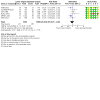


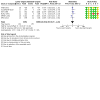
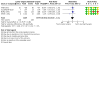
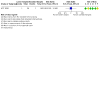
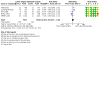

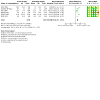

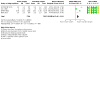
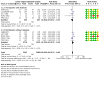

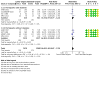
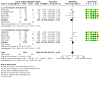
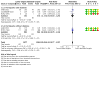
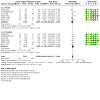
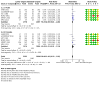

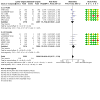

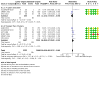
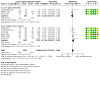

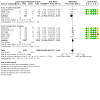


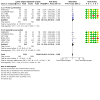
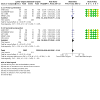





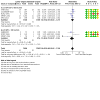
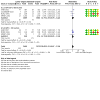
Update of
References
References to studies included in this review
AASK 2002 {unpublished data only}
ACCORD BP 2010 {unpublished data only}
HOT 1998 {unpublished data only}
-
- Hansson L, Zanchetti A, Carruthers SG, Dahlof B, Elmfeldt D, Julius S, et al. Effects of intensive blood-pressure lowering and low-dose aspirin in patients with hypertension: principal results of the Hypertension Optimal Treatment (HOT) randomised trial. HOT Study Group. Lancet 1998;351(9118):1755-62. [DOI: 10.1016/s0140-6736(98)04311-6] - DOI - PubMed
MDRD 1994 {published data only (unpublished sought but not used)}
-
- Klahr S, Levey AS, Beck GJ, Caggiula AW, Hunsicker L, Kusek JW, et al. The effects of dietary protein restriction and blood-pressure control on the progression of chronic renal disease. Modification of Diet in Renal Disease Study Group. New England Journal of Medicine 1994;330(13):877-84. [PMID: 10.1056/NEJM199403313301301] - DOI - PubMed
SPRINT 2015 {unpublished data only}
References to studies excluded from this review
BBB 1994 {published data only}
Cardio‐Sis 2014 {published data only}
INFINITY 2019 {published data only}
NCT01230216 {published data only}
-
- NCT01230216. Effect of intensive blood pressure control on progression of coronary atherosclerosis: randomized evaluation by intravascular ultrasound (PREVUS). clinicaltrials.gov/ct2/show/NCT01230216 (first received 29 October 2010).
PODCAST 2013 {published data only}
-
- Blackburn DJ, Krishnan K, Fox L, Ballard C, Burns A, Ford GA, et al. Prevention of decline in cognition after stroke trial (PODCAST): a study protocol for a factorial randomised controlled trial of intensive versus guideline lowering of blood pressure and lipids. Trials 2022;14:401. [DOI: 10.1186/1745-6215-14-401] - DOI - PMC - PubMed
RESTART‐AP 2013 {published data only}
-
- Arima H, Wang J, Bladin C, Heeley E, Billot L, Barzi F, et al. Rationale of the REstart or Stop Antithrombotics Randomised Trial in Asia Pacific (RESTART-AP). Cerebrovascular Diseases (Basel, Switzerland) 2013;36 (Suppl 1):39-40. [DOI: 10.1159/000353795] - DOI
References to studies awaiting assessment
ABCD‐H 1998 {published data only}
-
- Estacio RO, Jeffers BW, Hiatt WR, Biggerstaff SL, Gifford N, Schrier RW. The effect of nisoldipine as compared with enalapril on cardiovascular outcomes in patients with non-insulin-dependent diabetes and hypertension. New England Journal of Medicine 1998;338(10):645-52. [DOI: 10.1056/NEJM199803053381003] - DOI - PubMed
Lewis 1999 {published data only}
NCT00198562 {published data only}
-
- NCT00198562. Hypertension control based on home blood pressure [Hypertension control based on HOme Systolic Pressure Study (HOSP Study)]. clinicaltrials.gov/ct2/show/NCT00198562 (first received 20 September 2005) .
PRESERVE 2018 {published data only}
-
- Croall ID, Tozer DJ, Moynihan B, Khan U, O'Brien JT, Morris RG, et al. Effect of standard vs intensive blood pressure control on cerebral blood flow in small vessel disease: the PRESERVE randomized clinical trial. JAMA Neurology 2018;75(6):720-7. [DOI: 10.1001/jamaneurol.2017.5153] - DOI - PMC - PubMed
REIN2 2005 {published data only}
-
- Ruggenenti P, Perna A, Loriga G, Ganeva M, Ene-Iordache B, Turturro M, et al. Blood-pressure control for renoprotection in patients with non-diabetic chronic renal disease (REIN-2): multicentre, randomised controlled trial. Lancet 2005;365(9463):939-46. [DOI: 10.1016/S0140-6736(05)71082-5] - DOI - PubMed
RESPECT 2019 {published data only}
STEP 2021 {published data only}
-
- Zhang W, Zhang S, Deng Y, Wu S, Ren J, Sun G, et al, STEP Study Group. Trial of intensive blood-pressure control in older patients with hypertension [Strategy of systolic blood pressure intervention in the elderly hypertensive patients: a prospective randomized open-label blinded-endpoint trial]. New England Journal of Medicine 2021;385(14):1268-79. [DOI: 10.1056/NEJMoa2111437] - DOI - PubMed
References to ongoing studies
ESH CHL SHOT 2013 {published data only}
-
- Mancia G, Fagard R, Narkiewicz K, Redon J, Zanchetti A, Böhm M, et al. 2013 ESH/ESC guidelines for the management of arterial hypertension: the Task Force for the Management of Arterial Hypertension of the European Society of Hypertension (ESH) and of the European Society of Cardiology (ESC). European Heart Journal 2013;34:2159-219. [DOI: 10.1093/eurheartj/eht151] - DOI - PubMed
ESPRIT 2019 {published data only}
-
- Liu J, Wang B, Li Y, Yan X, Ge J, Li J. Rationale and design of the Effects of intensive Systolic blood Pressure lowering treatment in reducing RIsk of vascular evenTs (ESPRIT): a multicenter open-label randomized controlled trial. American Heart Journal 2023;257:93-102. [DOI: 10.1016/j.ahj.2022.12.003] [PMID: ] - DOI - PubMed
-
- NCT04030234. Effects of intensive systolic blood pressure lowering treatment in reducing risk of vascular events (ESPRIT) study. clinicaltrials.gov/ct2/show/NCT04030234 (first received 23 July 2019) .
PERFORMANCE 2017 {published data only}
-
- NCT02975505. Pilot to examine risk and feasibility of remote management of BP From CKD through ESRD (PERFORMANCE). clinicaltrials.gov/ct2/show/NCT02975505 (first received 29 November 2016) .
Additional references
ACC/AHA 2018
-
- Whelton PK, Carey RM, Aronow WS, Casey DE Jr, Collins KJ, Dennison Himmelfarb C, et al. ACC/AHA/AAPA/ABC/ACPM/AGS/APhA/ASH/ASPC/NMA/PCNA Guideline for the Prevention, Detection, Evaluation, and Management of High Blood Pressure in Adults: Executive Summary: A Report of the American College of Cardiology (ACC)/American Heart Association (AHA) Task Force on Clinical Practice Guidelines. Hypertension 2018;71(6):1269-324. [DOI: 10.1161/HYP.0000000000000066] - DOI - PubMed
Aftab 2020
Alsaad 2007
Arguedas 2009
Arguedas 2013
Auer 2018
Balshem 2011
-
- Balshem H, Helfand M, Schünemann HJ, Oxman AD, Kunz R, Brozek J, et al. GRADE guidelines: 3. Rating the quality of evidence. Journal of Clinical Epidemiology 2011;64(4):401-6. - PubMed
Beckett 2008
Bundy 2017
Cellesi 2015
Covidence 2018 [Computer program]
-
- Covidence. Version accessed 8 July 2019. Melbourne, Australia: Veritas Health Innovation, 2019. Available at https://www.covidence.org.
Deeks 2023
-
- Deeks JJ, Higgins JP, Altman DG (editors). Chapter 10: Analysing data and undertaking meta-analyses. In: Higgins JP, Thomas J, Chandler J, Cumpston M, Li T, Page MJ, Welch VA (editors). Cochrane Handbook for Systematic Reviews of Interventions version 6.4 (updated August 2023). Cochrane, 2023. Available from www.training.cochrane.org/handbook.
ESC/ESH 2018
ESH 2023
-
- Mancia G, Kreutz R, Brunström M, Burnier M, Grassi G, Januszewicz A, et al. 2023 ESH Guidelines for the management of arterial hypertension. The Task Force for the management of arterial hypertension of the European Society of Hypertension Endorsed by the International Society of Hypertension (ISH) and the European Renal Association (ERA). Journal of Hypertension 2023;41:1-198. [DOI: 10.1097/HJH.0000000000003480] - DOI - PubMed
Ettehad 2016
Fan 2017
-
- Fan F, Yuan Z, Qin X, Li J, Zhang Y, Li Y, et al. Optimal systolic blood pressure levels for primary prevention of stroke in general hypertensive adults: findings from the CSPPT (China Stroke Primary Prevention Trial). Hypertension 2017;69(4):697-704. [DOI: 10.1161/hypertensionaha.116.08499] - DOI - PubMed
Farnett 1991
Flemyng 2020
Flynn 2011
Gaffney 2021
Garrison 2017
Go 2004
-
- Go AS, Chertow GM, Fan D, McCulloch CE, Hsu CY. Chronic kidney disease and the risks of death, cardiovascular events, and hospitalization. New England Journal of Medicine 2004;351:1296-305. [PMID: ] - PubMed
GRADEpro GDT [Computer program]
-
- GRADEpro GDT. Version accessed 12 November 2021. Hamilton (ON): McMaster University (developed by Evidence Prime), 2021. Available from https://www.gradepro.org.
Higgins 2011
-
- Higgins JP, Green S. Cochrane Handbook for Systematic Reviews of Interventions Version 5.1.0 (updated March 2011). The Cochrane Collaboration, 2011. Available from training.cochrane.org/handbook/archive/v5.1/.
Higgins 2022
-
- Higgins JP, Thomas J, Chandler J, Cumpston M, Li T, Page MJ, Welch VA, editor(s). Cochrane Handbook for Systematic Reviews of Interventions Version 6.3 (updated February 2022). Cochrane 2022. Available from www.training.cochrane.org/handbook.
Higgins 2023
-
- Higgins JP, Eldridge S, Li T. Chapter 23: Including variants on randomized trials [last updated October 2019]. In: Higgins JP, Thomas J, Chandler J, Cumpston M, Li T, Page MJ, Welch VA (editors). Cochrane Handbook for Systematic Reviews of Interventions version 6.5. Cochrane, 2024. Available from www.training.cochrane.org/handbook.
Higgins 2024
-
- Higgins JP, Savović J, Page MJ, Elbers RG, Sterne JA. Chapter 8: Assessing risk of bias in a randomized trial [last updated October 2019]. In: Higgins JP, Thomas J, Chandler J, Cumpston M, Li T, Page MJ, Welch VA (editors). Cochrane Handbook for Systematic Reviews of Interventions version 6.5. Cochrane, 2024. Available from www.training.cochrane.org/handbook.
Hill 2008
Hypertension CANADA 2020
-
- Rabi DM, McBrien KA, Sapir-Pichhadze R, Nakhla M, Ahmed SB, Dumanski SM, et al. Hypertension Canada's 2020 Comprehensive Guidelines for the Prevention, Diagnosis, Risk Assessment, and Treatment of Hypertension in Adults and Children. Canadian Journal of Cardiology 2020;36(5):596-624. [DOI: 10.1016/j.cjca.2020.02.086] - DOI - PubMed
ICH 1994
-
- International Conference on Harmonization of Technical Requirements for Registration of Pharmaceuticals for Human Use. ICH Harmonized Tripartite Guideline: Clinical Safety Data Management: Definitions and Standards for Expedited Reporting E2A; October 1994. Available at www.ema.europa.eu/en/ich-e2a-clinical-safety-data-management-definitions... (accessed 02 August 2023).
ISH 2020
Jafar 2003
-
- Jafar TH, Stark PC, Schmid CH, Landa M, Maschio G, Jong PE, et al. Progression of chronic kidney disease: the role of blood pressure control, proteinuria, and angiotensin-converting enzyme inhibition: a patient-level meta-analysis. Annals of Internal Medicine 2019;139(4):244-52. [DOI: 10.7326/0003-4819-139-4-200308190-00006] - DOI - PubMed
James 2014
-
- James PA, Oparil S, Carter BL, Cushman WC, Dennison-Himmelfarb C, Handler J, et al. 2014 Evidence-Based Guideline for the Management of High Blood Pressure in Adults: Report from the Panel Members Appointed to the Eighth Joint National Committee (JNC 8). JAMA 2014;311(5):507-20. [DOI: 10.1001/jama.2013.284427] - DOI - PubMed
Kannel 1996
KDIGO 2012
-
- CKD-MBD Update Work Group. Kidney Disease: Improving Global Outcomes (KDIGO) Blood Pressure Work Group. KDIGO Clinical Practice Guideline for the Management of Blood Pressure in Chronic Kidney Disease. Kidney International Supplements 2012;2(5):337-414.
KDIGO 2013
KDIGO 2021
Klag 1996
Klahr 1997
-
- Klahr S. Prevention of progression of nephropathy. Nephrology, Dialysis, Transplantation 1997;12(Suppl 2):63-6. [ISSN: 0931-0509] - PubMed
Kovesdy 2022
Ku 2019
-
- Ku E, Sarnak MJ, Toto R, McCulloch CE, Lin F, Smogorzewski M, et al. Effect of blood pressure control on long-term risk of end-stage renal disease and death among subgroups of patients with chronic kidney disease. Journal of the American Heart Association 2019;8:1-13. [DOI: 10.1161/JAHA.119.012749] - DOI - PMC - PubMed
Lewington 2002
-
- Lewington S, Clarke R, Qizilbash N, Peto R, Collins R, Prospective Studies Collaboration. Age-specific relevance of usual blood pressure to vascular mortality: a meta-analysis of individual data for one million adults in 61 prospective studies. Lancet 2002;360(9349):1903-13. [ISSN: 0140-6736] - PubMed
Liu 2018
-
- Liu BC, Tang TT, Lv LL, Lan HY. Renal tubule injury: a driving force toward chronic kidney disease. Kidney International 2018;93(3):568-79. [DOI: 10.1016/ j.kint.2017.09.033] - PubMed
Lv 2013
-
- Lv J, Ehteshami P, Sarnak MJ, Tighiouart H, Jun M, Ninomiya T, et al. Effects of intensive blood pressure lowering on the progression of chronic kidney disease: a systematic review and meta-analysis. Canadian Medical Association Journal 2013;185(11):949-57. [DOI: 10.1503/cmaj.121468] - DOI - PMC - PubMed
MacMahon 1990
-
- MacMahon S, Peto R, Cutler J, Collins R, Sorlie P, Neaton J, et al. Blood pressure, stroke and coronary heart disease. Part 1. Prolonged differences in blood pressure: prospective observational studies collected for the regression dilution bias. Lancet 1990;335:765-74. [DOI: 10.1016/0140-6736(90)90878-9] - DOI - PubMed
Mahmoodi 2012
-
- Mahmoodi BK, Matsushita K, Woodward M, Blankestijn PJ, Cirillo M, Ohkubo T, et al, Chronic Kidney Disease Prognosis Consortium. Associations of kidney disease measures with mortality and end-stage renal disease in individuals with and without hypertension: a meta-analysis. Lancet 2012;380:1649-61. [DOI: 10.1016/S0140-6736(12)61272-0] - DOI - PMC - PubMed
Malhotra 2017
-
- Malhotra R, Nguyen HA, Benavente O, Mete M, Howard BV, Mant J, et al. Association between more intensive vs less intensive blood pressure lowering and risk of mortality in chronic kidney disease stages 3 to 5: a systematic review and meta-analysis. JAMA Internal Medicine 2017;177(10):1498-505. [DOI: 10.1001/jamainternmed.2017.4377] - DOI - PMC - PubMed
Mancia 2014
Mann 1992
-
- Mann JF, Hilgers KF, Veelken R, Geiger H, Schmieder RE, Luft FC. Effect of antihypertensive therapy on the progression of non-diabetic renal disease. Clinical Nephrology 1992;38 Suppl 1:S74-7. [PMID: ] - PubMed
Muntner 2010
-
- Muntner P, Anderson A, Charleston J, Chen Z, Ford V, Makos G, et al. Hypertension awareness, treatment, and control in adults with CKD: results from the Chronic Renal Insufficiency Cohort (CRIC) Study. American Journal of Kidney Disorders 2010;55(3):441-51. [DOI: 10.1053/j.ajkd.2009.09.014] - DOI - PMC - PubMed
Neal 1999
-
- Neal B, MacMahon S. An overview of 37 randomised trials of blood pressure lowering agents among 270,000 individuals. World Health Organization-International Society of Hypertension Blood Pressure Lowering Treatment Trialists' Collaboration. Clinical and Experimental Hypertension 1999;21(5-6):517-29. [DOI: 10.3109/10641969909060985] - DOI - PubMed
NICE 2019
-
- National Institute for Health and Clinical Excellence (NICE). Hypertension: The Clinical Management of Primary Hypertension in Adults: Update of Clinical Guidelines 18 and 34; 2011. Updated August 2019. London, UK: Royal College of Physicians , 2019. [PMID: ] - PubMed
NICE 2021
-
- National Institute for Health and Care Excellence (NICE). Chronic Kidney Disease: Assessment and Management; 2021. London, UK: National Institute for Health and Care Excellence (NICE), 2021. [PMID: ] [URL: www.ncbi.nlm.nih.gov/pubmed/34672500] - PubMed
Oparil 2003
Oxman 1992
-
- Oxman AD, Guyatt GH. A consumer's guide to subgroup analyses. Annals of Internal Medicine 1992;116:78-84. - PubMed
Page 2021
PSC 2002
Rashidi 2008
-
- Rashidi A, Sehgal AR, Rahman M, O'Connor AS. The case for chronic kidney disease, diabetes mellitus, and myocardial infarction being equivalent risk factors for cardiovascular mortality in patients older than 65 years. American Journal of Cardiology 2008;102:1668-73. [PMID: ] - PubMed
RevMan 2024 [Computer program]
-
- Review Manager (RevMan). Version 8.5.0. Copenhagen: The Cochrane Collaboration, 2024. Available at https://revman.cochrane.org.
Saiz 2018a
Saiz 2018b
-
- Saiz LC, Leache L, Erviti J. Individual patient data as a key modifier of Cochrane Review results: the SPS3 trial case. In: Abstracts of the 25th Cochrane Colloquium, Edinburgh, UK. Cochrane Database of Systematic Reviews 2018;9(Suppl 1):142. [DOI: 10.1002/14651858.CD201801] - DOI
Saiz 2022
Schaeffner 2008
Schünemann 2013
-
- Schünemann H, Brożek J, Guyatt G, Oxman A, editors. GRADE handbook for grading quality of evidence and strength of recommendations. The GRADE Working Group, October 2013. Available from guidelinedevelopment.org/handbook..
Stamler 1993
Sterne 2019
Sundstrom 2015
Thomas 2021
Thomopoulos 2014
Tierney 2023
-
- Tierney JF, Stewart LA, Clarke M. Chapter 26: Individual participant data. In: Higgins JP, Thomas J, Chandler J, Cumpston M, Li T, Page MJ, Welch VA (editors). Cochrane Handbook for Systematic Reviews of Interventions version 6.4 (updated August 2023). Cochrane, 2023. Available from www.training.cochrane.org/handbook.
Tomson 2021
-
- Tomson CR, Cheung AK, Mann JF, Chang TI, Cushman WC, Furth SL, et al. Management of blood pressure in patients with chronic kidney disease not receiving dialysis: synopsis of the 2021 KDIGO Clinical Practice Guideline. Annals of Internal Medicine 2021;174(9):1270-81. [DOI: 10.7326/m21-0834] - DOI - PubMed
Tsai 2017
-
- Tsai WC, Wu HY, Peng YS, Yang JY, Chen HY, Chiu YL, et al. Association of intensive blood pressure control and kidney disease progression in nondiabetic patients with chronic kidney disease. A systematic review and meta-analysis. JAMA Internal Medicine 2017;177:792-9. [DOI: 10.1001/jamainternmed.2017.0197] - DOI - PMC - PubMed
Upadhyay 2011
Verdecchia 2014
Vokó 1999
WHO 2021
-
- World Health Organization. Guideline for the Pharmacological Treatment of Hypertension in Adults. Geneva: World Health Organization, 2021 . [PMID: ] [URL: www.ncbi.nlm.nih.gov/pubmed/34495610] - PubMed
Wright 2002
Xie 2016
Yao 2021
Zanchetti 2003
-
- Zanchetti A, Hansson L, Clement D, Elmfeldt D, Julius S, Rosenthal T, et al, on behalf of the HOT Study Group. Benefits and risks of more intensive blood pressure lowering in hypertensive patients of the HOT study with different risk-profiles: does a J-shaped curve exist in smokers? Journal of Hypertension 2003;21:797-804. [DOI: 10.1097/00004872-200304000-00024] - DOI - PubMed
References to other published versions of this review
Erviti 2019
Publication types
MeSH terms
Substances
LinkOut - more resources
Full Text Sources
Medical

